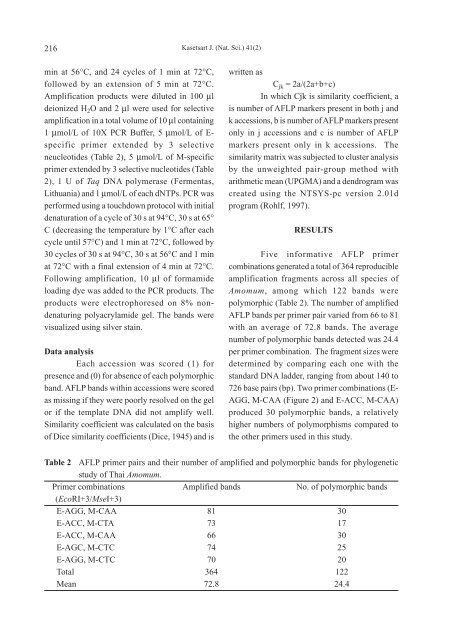April - June 2007 - Kasetsart University
April - June 2007 - Kasetsart University
April - June 2007 - Kasetsart University
Create successful ePaper yourself
Turn your PDF publications into a flip-book with our unique Google optimized e-Paper software.
216<br />
min at 56°C, and 24 cycles of 1 min at 72°C,<br />
followed by an extension of 5 min at 72°C.<br />
Amplification products were diluted in 100 µl<br />
deionized H 2O and 2 µl were used for selective<br />
amplification in a total volume of 10 µl containing<br />
1 µmol/L of 10X PCR Buffer, 5 µmol/L of Especific<br />
primer extended by 3 selective<br />
neucleotides (Table 2), 5 µmol/L of M-specific<br />
primer extended by 3 selective nucleotides (Table<br />
2), 1 U of Taq DNA polymerase (Fermentas,<br />
Lithuania) and 1 µmol/L of each dNTPs. PCR was<br />
performed using a touchdown protocol with initial<br />
denaturation of a cycle of 30 s at 94°C, 30 s at 65°<br />
C (decreasing the temperature by 1°C after each<br />
cycle until 57°C) and 1 min at 72°C, followed by<br />
30 cycles of 30 s at 94°C, 30 s at 56°C and 1 min<br />
at 72°C with a final extension of 4 min at 72°C.<br />
Following amplification, 10 µl of formamide<br />
loading dye was added to the PCR products. The<br />
products were electrophoresed on 8% nondenaturing<br />
polyacrylamide gel. The bands were<br />
visualized using silver stain.<br />
Data analysis<br />
Each accession was scored (1) for<br />
presence and (0) for absence of each polymorphic<br />
band. AFLP bands within accessions were scored<br />
as missing if they were poorly resolved on the gel<br />
or if the template DNA did not amplify well.<br />
Similarity coefficient was calculated on the basis<br />
of Dice similarity coefficients (Dice, 1945) and is<br />
<strong>Kasetsart</strong> J. (Nat. Sci.) 41(2)<br />
written as<br />
Cjk = 2a/(2a+b+c)<br />
In which Cjk is similarity coefficient, a<br />
is number of AFLP markers present in both j and<br />
k accessions, b is number of AFLP markers present<br />
only in j accessions and c is number of AFLP<br />
markers present only in k accessions. The<br />
similarity matrix was subjected to cluster analysis<br />
by the unweighted pair-group method with<br />
arithmetic mean (UPGMA) and a dendrogram was<br />
created using the NTSYS-pc version 2.01d<br />
program (Rohlf, 1997).<br />
RESULTS<br />
Five informative AFLP primer<br />
combinations generated a total of 364 reproducible<br />
amplification fragments across all species of<br />
Amomum, among which 122 bands were<br />
polymorphic (Table 2). The number of amplified<br />
AFLP bands per primer pair varied from 66 to 81<br />
with an average of 72.8 bands. The average<br />
number of polymorphic bands detected was 24.4<br />
per primer combination. The fragment sizes were<br />
determined by comparing each one with the<br />
standard DNA ladder, ranging from about 140 to<br />
726 base pairs (bp). Two primer combinations (E-<br />
AGG, M-CAA (Figure 2) and E-ACC, M-CAA)<br />
produced 30 polymorphic bands, a relatively<br />
higher numbers of polymorphisms compared to<br />
the other primers used in this study.<br />
Table 2 AFLP primer pairs and their number of amplified and polymorphic bands for phylogenetic<br />
study of Thai Amomum.<br />
Primer combinations Amplified bands No. of polymorphic bands<br />
(EcoRI+3/MseI+3)<br />
E-AGG, M-CAA 81 30<br />
E-ACC, M-CTA 73 17<br />
E-ACC, M-CAA 66 30<br />
E-AGC, M-CTC 74 25<br />
E-AGG, M-CTC 70 20<br />
Total 364 122<br />
Mean 72.8 24.4
















